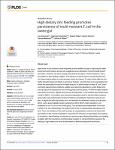High dietary zinc feeding promotes persistence of multi-resistant E. coli in the swine gut
Ciesinski, Lisa
Guenther, Sebastian
Pieper, Robert
Kalisch, Martin
Bednorz, Carmen
Wieler, Lothar H.
High levels of zinc oxide are used frequently as feed additive in pigs to improve gut health and growth performance and are still suggested as an alternative to antimicrobial growth promoters. However, we have recently described an increase of multi-resistant E. coli in association to zinc feeding in piglets. This previous study focused on clonal diversity of E. coli, observing the effect on multi-resistant strains by chance. To shed further light into this highly important topic and falsify our previous findings, we performed a zinc pig feeding trial where we specifically focused on in-depth analysis of antimicrobial resistant E. coli. Under controlled experimental conditions, piglets were randomly allocated to a high dietary zinc (zinc group) and a background zinc feeding group (control group). At different ages samples were taken from feces, digesta, and mucosa and absolute E. coli numbers were determined. A total of 2665 E. coli isolates were than phenotypically tested for antimicrobial resistance and results were confirmed by minimum inhibitory concentration testing for random samples. In piglets fed with high dietary zinc, we detected a substantial increase of multi-resistant E. coli in all gut habitats tested, ranging from 28.9–30.2% multi-resistant E. coli compared to 5.8–14.0% in the control group. This increase was independent of the total number of E. coli. Interestingly, the total amount of the E. coli population decreased over time. Thus, the increase of the multi-resistant E. coli populations seems to be linked with persistence of the resistant population, caused by the influence of high dietary zinc feeding. In conclusion, these findings corroborate our previous report linking high dietary zinc feeding of piglets with the occurrence of antimicrobial resistant E. coli and therefore question the feeding of high dietary zinc oxide as alternative to antimicrobial growth promoters.
No license information

